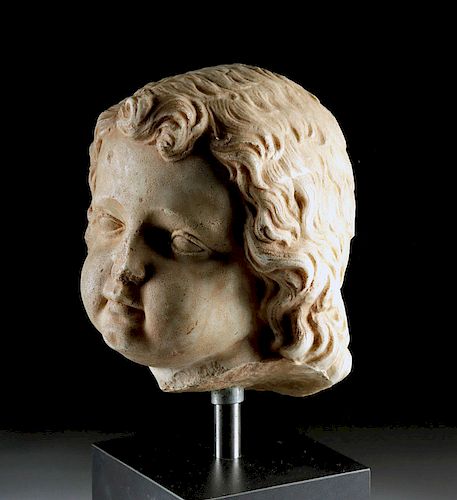Roman Marble Head of a Child
Lot 60b
About Seller
Artemis Fine Arts
686 S Taylor Ave, Ste 106
Louisville, CO 80027
United States
Selling antiquities, ancient and ethnographic art online since 1993, Artemis Gallery specializes in Classical Antiquities (Egyptian, Greek, Roman, Near Eastern), Asian, Pre-Columbian, African / Tribal / Oceanographic art. Our extensive inventory includes pottery, stone, metal, wood, glass and textil...Read more
Estimate:
$11,000 - $16,500
Absentee vs Live bid
Two ways to bid:
- Leave a max absentee bid and the platform will bid on your behalf up to your maximum bid during the live auction.
- Bid live during the auction and your bids will be submitted real-time to the auctioneer.
Bid Increments
| Price | Bid Increment |
|---|---|
| $0 | $25 |
| $300 | $50 |
| $1,000 | $100 |
| $2,000 | $250 |
| $5,000 | $500 |
| $10,000 | $1,000 |
| $20,000 | $2,500 |
| $50,000 | $5,000 |
| $100,000 | $10,000 |
| $200,000 | $20,000 |
About Auction
By Artemis Fine Arts
Jun 20, 2019
Set Reminder
2019-06-20 10:00:00
2019-06-20 10:00:00
America/New_York
Bidsquare
Bidsquare : Ancient / Ethnographic From Around the World
https://www.bidsquare.com/auctions/artemis-gallery/ancient-ethnographic-from-around-the-world-4217
Around the world & back in time - be amazed at the treasures you will find. Antiquities from Egypt, Greece, Italy and the Near East, Asian, Pre-Columbian, African / Tribal / Oceanic, Native American, Spanish Colonial, Russian Icons, Fine Art, much more! All categories, all price ranges.. all legal Artemis Fine Arts info@artemisgallery.com
Around the world & back in time - be amazed at the treasures you will find. Antiquities from Egypt, Greece, Italy and the Near East, Asian, Pre-Columbian, African / Tribal / Oceanic, Native American, Spanish Colonial, Russian Icons, Fine Art, much more! All categories, all price ranges.. all legal Artemis Fine Arts info@artemisgallery.com
- Lot Description
Roman, Imperial Period, ca. 1st century CE. A life-like, sensitive portrayal in marble of a child's head, with a sweet visage comprised of heavy-lidded almond-shaped eyes, delicate brow line leading to a petite nose, full pursed, heart-shaped lips delineated with a naturalistic philtrum above, a petite chin, and pudgy apple cheeks confirming his childlike traits - all framed by a wavy coiffure of thick locks, parted to the side and softly cascading in S-shaped waves from the crown of his head to his shoulders, with wispy curls above his forehead. The head is tilted slightly toward the right, suggesting a steadfast gaze. During the Roman Imperial period, children were popular subjects for sculpture displayed in both the private and public arena. Size: 6.5" L x 6.25" W x 7.5" H (16.5 cm x 15.9 cm x 19 cm); 13.25" H (33.7 cm) on included custom stand.
Ancient literature confirms that the Romans cherished childhood and appreciated a nostalgia for its innocence, playful behavior, and gentleness. In addition, children played a role in mythology - i.e. the well-known myth of a boy strangling a goose may have been a domesticated parody of Hercules (Greek Herakles) strangling serpents as an infant. Children were also often depicted interacting with animals in a friendly manner - suggesting that the ancients appreciated the emotional and social benefits of keeping pets.
Provenance: private East Coast collection; ex-William Froelich, New York and California (New York) and Saba (Caribbean), acquired in 1970s
All items legal to buy/sell under U.S. Statute covering cultural patrimony Code 2600, CHAPTER 14, and are guaranteed to be as described or your money back.
A Certificate of Authenticity will accompany all winning bids.
We ship worldwide and handle all shipping in-house for your convenience.
#142451Loss to nose. Old chip to forehead. Loss to neckline as shown - likely a section from a larger statue. Surface covered with red earthen deposits. Areas of mineral deposits.Condition
- Shipping Info
-
All shipping is handled in-house for your convenience. Your invoice from Artemis Gallery will include shipping calculation instructions. If in doubt, please inquire BEFORE bidding for estimated shipping costs for individual items.
-
- Buyer's Premium



 EUR
EUR CAD
CAD AUD
AUD GBP
GBP MXN
MXN HKD
HKD CNY
CNY MYR
MYR SEK
SEK SGD
SGD CHF
CHF THB
THB














